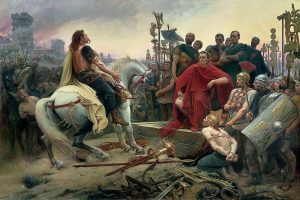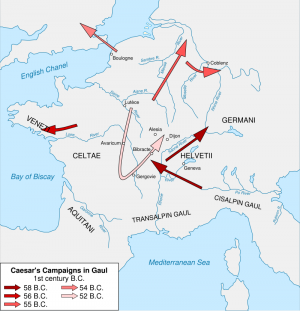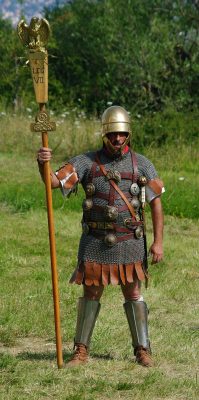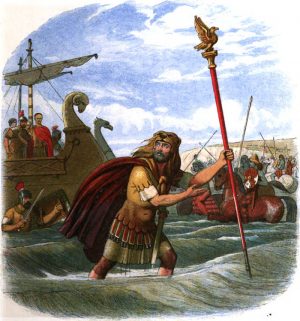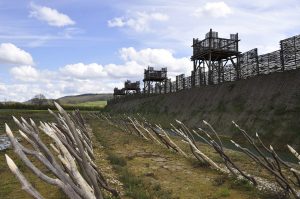The Gallic wars transpired from 58 to 50 BC at the time of Julius Caesar’s Roman proconsulship of the Gaul. Rome had already conquered Southern Gaul by this time, but British, Gallic, and Germanic tribes still occupied some areas. Both sides had differing battle strategies, with the Roman military preferring an organized and disciplined approach while the Gauls were more unruly and adopted a warrior culture.
The Romans were also more advanced in their equipment, but the Gauls had the physical advantage of being larger. Despite the equal strength of the Roman army and the Gallic tribes, the latter lacked unity and cooperation. Ultimately, Rome was victorious by the end of the last battle, the Battle of Alesia. The Roman politician and general Caesar wrote and released commentaries on this military triumph in De Bello Gallico, which translates to “On the Gallic War.”
Background
In 60 BC, Julius Caesar became part of the political alliance that ruled over Rome, the First Triumvirate. This alliance included two other triumvirs: the great general Gnaeus Pompeius Magnus and the extremely wealthy Marcus Licinius Crassus. They were each assigned to provinces which they would reign over.
Caesar was given control over Cisalpine Gaul, Illyricum, and Transalpine Gaul for five years as the proconsul. With these areas, Julius Caesar was able to gain command over four experienced legions: VII, VIII, IX, and X. These soldiers had already previously battled alongside Caesar in Hispania.
Due to his substantial debt from his efforts to seize power as the consul of Gaul, Caesar decided that expanding Roman territory in Gaul would be the best way to enrich himself and Rome.
Against the Helvetii
In order to start his military campaign in Gaul, Caesar needed a casus belli—a reason to attack —to gain control over the rest of Gaul. At the same time, in 61 BC, the Helvetii from Switzerland were planning to move to Southern Gaul, burning their houses to fortify the need to migrate. The Helvetii were a Celtic tribe led by Orgetorix, who committed suicide due to his perceived tyranny and was eventually replaced by Divico. The Romans had an ally in the area that the Helvetii were to traverse through, the Aedui.
The Roman military marched up to Geneva, where the Helvetii would pass, ready for their opponents. They destroyed the bridge to Gaul, hindering the Helvetiis’ journey. When the Celtic tribe arrived, they requested passage to the area. To them, it seemed as though Caesar was considering their appeal. Meanwhile, the Romans set up a fortified structure instead. Small groups of Helvetii decided to cross the river but were met by attacks from the Romans. Consequently, the remaining Helvetii soldiers decided to pass through another route, which took them through the mountains.
In 58 BC, Caesar went back to Italy to gather more troops while the Helvetii were able to enter Gallic territory, pillaging Bibracte, the capital of the Aedui people. The Gauls implored Caesar to help them, and he eagerly accepted. In March of 58 BC, the Battle of Bibracte ensued. The Romans had a strong infantry, but the Helvetii also had the upper hand with their cavalry. In the end, the Romans legions’ experience, unity, and discipline found them victorious against the Helvetii. The Celtic tribe surrendered and retreated to their homeland.
Against the Suebi
Caesar needed more cause to further expand Roman control over Gaul. Another opportunity presented itself when Diviciacus brought up the Seubi’s’ attempts to conquer the Aeduian areas, taking hostages, so Caesar had another casus belli. The Harudes, who were allied with the Suebi, attacked the Aedui.
This event gave Caesar another reason to defend the Aedui and conquer more land in Gaul. The Roman legions were increasingly trusting of Caesar’s role as their general, which positively impacted their morale. The Roman army defeated the Suebi, led by Ariovistus, in the Battle of Vosges in 58 BC. Caesar claims that they were able to kill around 120,000 of Ariovistus’ soldiers.
Against the Belgae
Rome’s victory over the Suebi gave rise to unrest among the other Gallic tribes who felt threatened by Caesar’s conquests in Gaul. The Belgae had similarly attacked another one of Rome’s allies. This event allowed Caesar to march on them before they took the main settlement of the Remi tribe, an ally of Rome. The Roman army traveled to Belgic Suessiones’ oppidum, their main settlement, and lay siege to it. The Belgic army attempted to reach their main settlement in the cover of the night, but the nature of the Romans’ siege eventually caused them to surrender.
Against the Nervii
The Nervii were a Belgic tribe from Northern Gaul. In 57 BC, they united with the Atrebates, Atuatuci, and Viromandui tribes of Gaul in an ambush attack against the Roman legions at river Sambre. The overwhelming number of the Nervii while two of Caesar’s legions were still on their way to the river put the Nervii at an upper hand during the beginning of the battle of the Sabis.
Once again, the strength of the Roman army was their training. They had been in many battles before, which kept them from an immediate defeat. The situation for the Romans became so dire that Caesar himself arrived at the front lines of the battle. His appearance boosted the morale of the legions. He commanded the soldiers to form squares to increase their protection as a group. The arrival of reinforcements from Legion X saved the Romans from defeat. Legion X drove back the Nervii, garnering the win for the Romans.
Against the Veneti
In 56 BC, Caesar took the Roman army to winter in northern Gaul. At this point, they had accumulated many victories over the territory, and the people of the area were forced to provide shelter and food for the Roman soldiers. Roman officers visited the Veneti to ask for grain that winter.
The Veneti were a tribe that lived in northwest Gaul. They had negotiated with the tribes of Armorica, forming an alliance against the Romans. Thus, when the Roman officers came to their territory, they were captured in order to start a conflict with the Romans.
The Veneti and the other tribes in the area were near the Atlantic coast, ensuring their mastery over the waters. The Romans were not as prepared in naval warfare; however, the geography of Veneti territory pushed them to gather a fleet with Decimus Brutus as the prefect. Much of the campaign was in favor of the Veneti. The Romans were not as experienced and well-equipped. They were stuck at the harbor due to the strong waters.
Once the weather was clear, the Romans set out to the Gulf of Morbihan, where the Battle of Morbihan ensued. The Veneti seemed to have a sturdy and superior fleet of ships; however, the Romans used a different method to claim the victory. They used grappling hooks to climb onto Veneti ships, and with their excellent fighting prowess, the Veneti’s naval forces were overwhelmed. Without their fleets, the Veneti surrendered to the Romans.
More Revolts
In 54 BC, in order to promote himself above his fellow triumvirs, Caesar proceeded to embark on expeditions to cross the Rhine and the English Channel. He also invaded Britain and gained another victory, making them Roman subjects.
However, when Caesar arrived back in Gaul, tensions rose because Caesar once again took his legions to Gaul for the winter and expected the tribes to feed them. This year was especially difficult for the tribes due to the unsuccessful harvesting season. Caesar decided to spread his men to lessen the burden on each tribe.
The Gallic-Germanic tribe of the Eburones planned a revolt against the Romans and ambushed a legion under Quintus Titurius Sabinus and Lucius Aurunculeius Cotta. Both were high-ranking members of the Roman army. This event caused other tribes such as the Nervii and Atuatuci to revolt as well. This time the Gauls were able to defeat the Romans, which eventually undermined their hold in the territory.
After the Romans’ loss in winter, Caesar was determined to gain control over the Gauls; he wanted them under complete subjugation. This campaign was harsh and brutal. Caesar had his legions raid and terrorize entire populations and included civilians in the attacks.
The Germanic tribes went so far as to help the Treveri, another Celtic tribe in Gaul. Titus Labienus, a lieutenant, was able to successfully defeat them through a feigned retreat. His army pretended to retreat on a hillside but began attacking the Treveri, who wasted their energy climbing the hill.
In 52 BC Vercingetorix, the leader of the Arverni tribe, was able to unite the forces of Gaul against the Romans. The tribes all feared that the Romans would wreck the king of the Gallic holy land. Although they had previously had ununified revolts, this one goal was able to bring them together. Vercingetorix planned to starve the Roman legions by attacking the sources of Roman supplies such as supply trains and foragers. Not much information is available about the Battle of Gergovia that followed, but the clear victor was the Gallian alliance.
The Battle of Alesia
The decisive fight for control over Gaul was the Battle of Alesia. Vercingetorix chose to defend Alesia, home of the Mandubii, a small Gallic tribe. The Romans laid siege to Alesia. They set up a trench with booby-traps to fortify it, a moat to rival any cavalry, and towers, ready for the siege. Vercingetorix knew that the Romans would outlast the defenders within Alesia and surrendered.
Southwest Gaul
After the Battle of Alesia there were only two chiefs in Southwest of Gaul who were still not fully under Roman control. They were Drappes of the Senonians and Lucterius of the Cadurci. The Romans laid siege this time at Uxellodunum, with Roman general Gaius Caninius Rebilus leading the legions in the siege.
The Cadurci had dug a tunnel system for their water supply into their settlement. However, the Romans diverted their water supply as they too dug their own tunnels. The Cadurci took the drying up of their water supply as a signal from the gods. They surrendered soon after.
